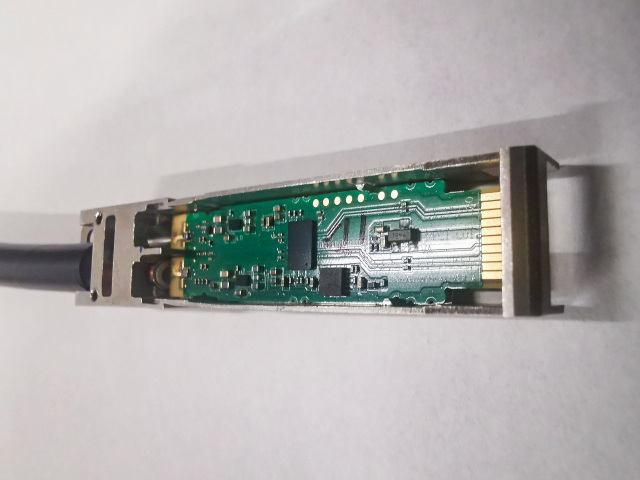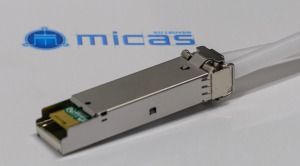Article By : Nitin Dahad

KU Leuven has successfully tested a polymer microwave fiber transceiver module; it should cut costs in data centers. An EE Times exclusive.
Belgian research institute KU Leuven said it has successfully tested a polymer microwave fiber (PMF) based transceiver module housed in an industry standard SFP28 enclosure. This is expected to find its way into commercial production for data center applications with a leading Chinese network equipment manufacturer by the end of 2022.

In an exclusive briefing with EE Times, Patrick Reynaert, a professor at KU Leuven, focused on RF, mmWave and terahertz CMOS and SOI circuits, explained the significance of integrating mmWave transceiver chips, small antennas and a cheap plastic fiber in a standard pluggable product for data centers. Within a datacenter, high-speed connections are established by using short-range optical links, but both their cost and their power consumption have become a major concern. Providers of network infrastructure are looking for ways to increase the energy efficiency of their products, while at the same time reducing the cost.
PMF technology combines the advantages of optical communication with those of communication over copper wires. It can achieve high data rates with very low latency, and it is insensitive to electromagnetic interference. At the same time, it is also low cost, and its mechanical robustness is superior to that of optical links. PMF is not intended to replace long-distance communication links. However, its potential in short- and medium-distance applications is significant.
Reynaert said, “We have a sweet spot — good channel and low power consumption for small range.” He added that instead of using directive antennas, the use of directive channels can help solve the challenges of free space path loss at high frequency.
The work on PMF is led by Reynaert within the MICAS group at KU Leuven. One of this group’s research partners, a Chinese network equipment manufacturer who Raynaert said they cannot name, is commercializing a PMF-based product for the data center market. This will be a fully integrated transceiver, acting as the interface between a network switch and the cable (in this case a polymer fiber) in a top-of-rack configuration. The transceiver is housed in an industry standard SFP28 connection.

The PMF front-end chips, fabricated in a 28nm technology and operating at 135GHz, were combined with a clock and data recovery chip and a baseband processing chip to develop the complete PMF pluggable module. The module was field tested in a data server facility. Data rates of 25.78Gbps were achieved, while keeping the power consumption at a considerably lower level – around 30% to 50% of the power consumed by more expensive optical modules. Because it is housed in a SFP28 enclosure, it is fully compatible with current network switch configurations, enabling an easy market introduction.

Reynaert explained that these successful field tests demonstrate that PMF technology has matured up to the level of commercialization. He said the MICAS group, together with its research partners, has been successful in going from fundamental research, over applied research, towards actual technology transfer to the market. With this milestone completed, Reynaert and his group are now moving to the next target: breaking the 100 Gbps barrier. They want to be able further demonstrate the potential of PMF in data centers and various other applications.
Reynaert received the Bell Labs prize for his work on PMF communication technology in 2014, and since then his research group has evolved from studying the fundamental research problems to demonstrating full communication links in various applications. The polymer microwave fiber is essentially a dielectric waveguide that carries an electromagnetic wave between radio transmitter and receiver at both ends of the fiber. The typical frequency of the wave is above 100 GHz in order to have an efficient coupling and propagation in the fiber, while at the same time keeping the fiber diameter small. Reynaert’s group and its expertise in the design of high-frequency circuits in standard silicon chip fabrication technologies meant they have been able to demonstrate the capabilities of an entire PMF link.
This article was originally published on EE Times.
Nitin Dahad is a correspondent for EE Times, EE Times Europe and also Editor-in-Chief of embedded.com. With 35 years in the electronics industry, he’s had many different roles: from engineer to journalist, and from entrepreneur to startup mentor and government advisor. He was part of the startup team that launched 32-bit microprocessor company ARC International in the US in the late 1990s and took it public, and co-founder of The Chilli, which influenced much of the tech startup scene in the early 2000s. He’s also worked with many of the big names – including National Semiconductor, GEC Plessey Semiconductors, Dialog Semiconductor and Marconi Instruments.


